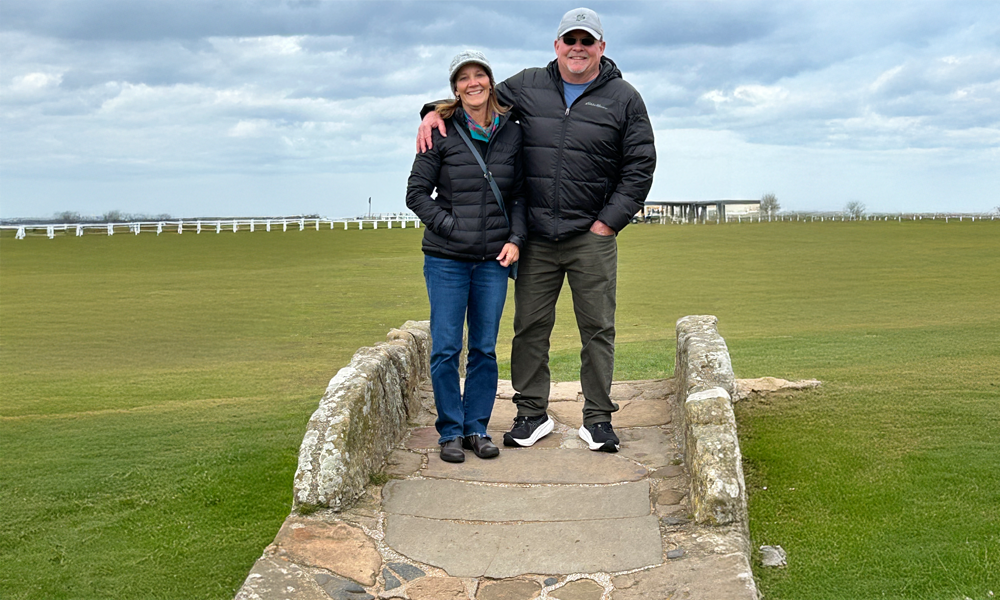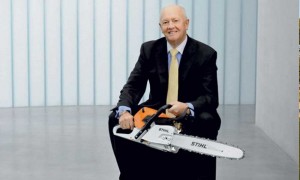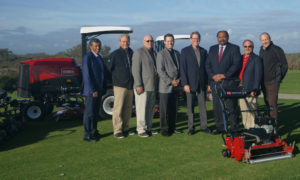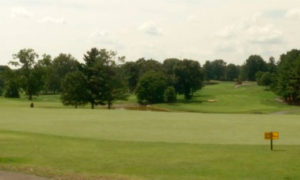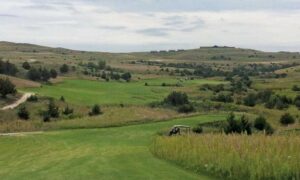This column features recollections of the author’s 37 years as a golf writer. These installments stem from his many travels and experiences, which led to a gradual understanding that the game has many intriguing components, especially its people.
Here’s Part 2 of my Q&A with Mark Miller, a talented and accomplished golf course architect as well as a fine musician and songwriter. He also wrote and published a popular children’s book.
While researching this article, I Googled “golf architects who play music” and found only a few with these two interests. Among them is Brandon Johnson with Arnold Palmer Design, who has a minor degree in Music from North Carolina State. Two others are Rick Jacobson and Brian Curley. Together with other “follically-challenged” ASGCA members, they play in a band called “Brian and the Bullet Heads.” And there’s Jeff Bradley. The bunker specialist and design associate at Coore & Crenshaw was a professional musician for 10 years before realizing that the late hours of gigs didn’t work for a family man.
But perhaps none of these have Miller’s musical chops. The Coloradoan explains his love of music and other outside interests in the second half of our Q&A.
Jeff Shelley: Please describe your contributions to non-golf projects such as books, music, art, water parks, etc. List any collaborators, successes, highlights, desired outcomes, etc.
Mark Miller: “Without really knowing it, I think I’ve always been a right-brain, creative, big-picture type person. In my mid-teens I began playing music and writing songs on the guitar. Later, I started on the banjo. I also like writing stories and coming up with wild ideas involving crazy characters, which are shown in my song lyrics. I never thought I’d make a living at either one. But I’ve kept working at it.
“So, over the last 40 to 50 years of writing songs, I’ve accumulated quite a few. I like to say I write a whole lot of bad ones and occasionally a good one. The test for me is if I like it and feel comfortable playing it in front of my friends. If that happens, it goes in the ‘good’ pile. I’ve probably averaged two good songs a year of writing them, which has added up over time.
“In the 1990s while working at Belt Collins in Hawaii, I became friends with a coworker, Murray Hutchins, who was also a musician and songwriter. We decided to build a recording studio to record our songs. We made an album named ‘Freaks of Nature,’ and passed it around. It got a good reception.
“Through my brother, we eventually were contacted by a lady, Meredith Hodges of the Lucky Three Ranch https://www.luckythreeranch.com/), who wanted to use our music on a project she was doing. Meredith is one of the world’s premiere mule and donkey trainers, and this was right up our alley. She hired us for several projects. Then we wrote her a song called ‘The First Time I Met My Mule,’ and she bought that from us. We felt honored that we found such a good fit for someone who liked our music. At the same time, we entered one of our songs in the John Lennon Song Writing Competition and won an honorable mention. Things were going well. But as we had careers and family, the music kind of took a back seat, as it usually does.
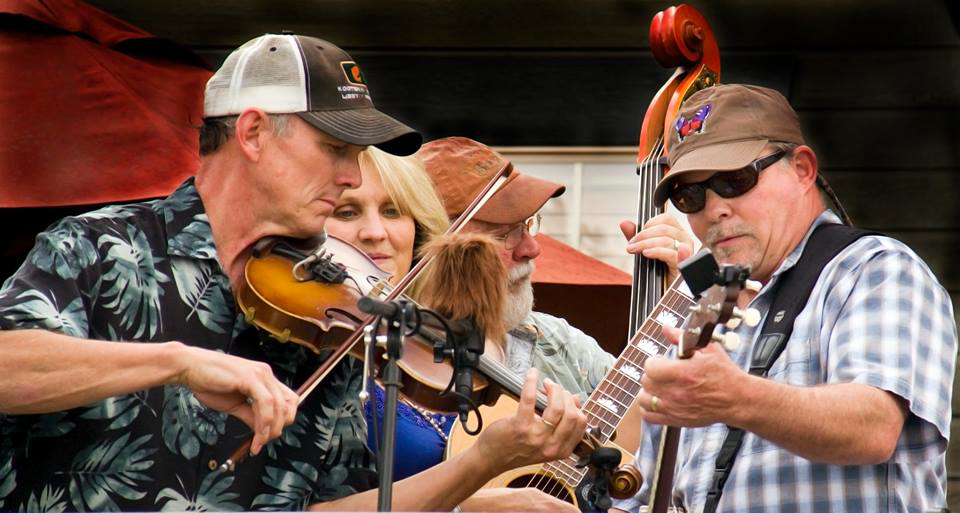
“While Murray and I were taking a long break from our musical collaboration, I met some fantastic musicians in Arvada, Colo., and we formed an acoustic four-piece band with fiddle, mandolin, banjo, guitar, dobro and standup bass. We called ourselves Gone Before They Got Here, aka The Goners. Our music was a blend of bluegrass, country, folk and blues. The band inspired me to write a lot more songs for our sets. For about eight years we had a blast playing at festivals, bars, weddings, parties, you name it. One of our favorite festivals had Jefferson Starship as the headliner, and they were amazing.
“Fast forward about 15 years when Murray and I reconnected. I called to tell him that during COVID I had entered a song in the American Songwriter Magazine competition and won first place. I couldn’t believe it. He asked if I had any new songs worth recording, so I sent him song demos. Within a short period of time, we rebuilt our recording studios with better recording technology, started recording new tunes and began streaming songs on different platforms. That led to the release of a new album of tunes called ‘Big Green Highway’ in November 2024 by our original band Freaks of Nature. We have enjoyed this so much that we’ve already started working on another one. We are music lovers, but realists. There are so many talented musicians out there now, but even small successes are very gratifying.
“Not only is it great to be working together again, but we are now making music with our brothers as well. My brother Blake is an unbelievably talented lead guitarist and songwriter, and we’ve played together our entire lives. Murray’s brother Chris is an outstanding stand-up bass player, so that’s our band. The ironic thing is we have never all been in the same room together playing. That’s today’s technology for you.
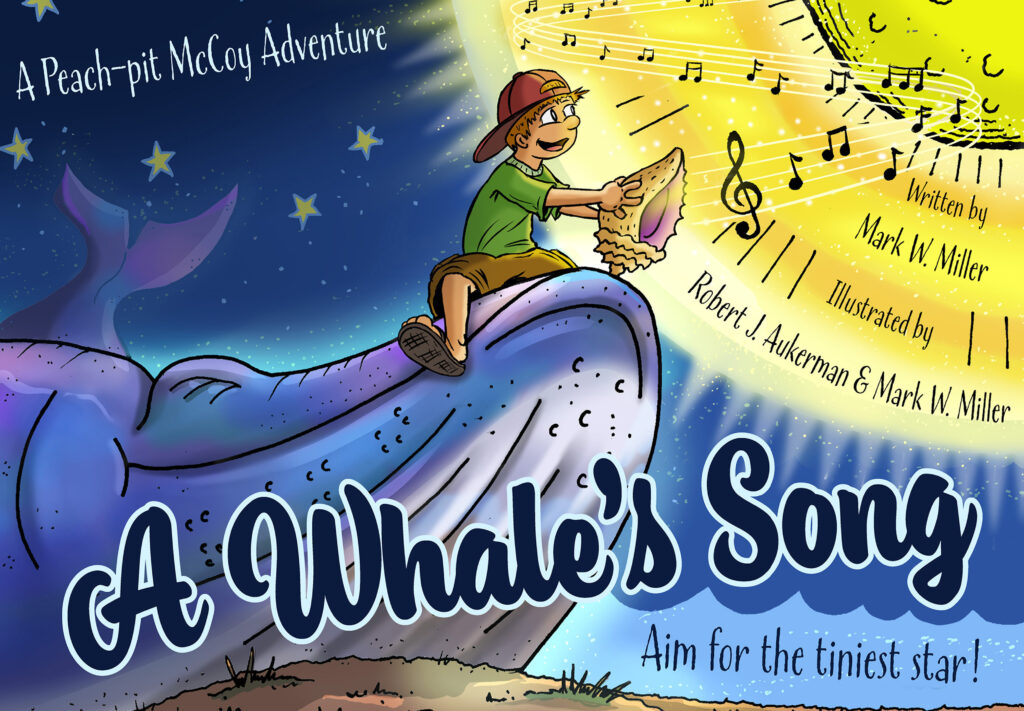
“Another one of my extracurricular ventures was writing a children’s book. I had written it years ago, but it just sat there. I then decided to finish it for our grandkids. A friend and talented artist, Robbie Aukerman, illustrated the book with colorful, whimsical drawings that really help make the story come alive. It’s a magical story about a boy walking along the beach one night under the moon and stars. Suddenly, he discovers a beached humpback whale and must figure out how to save its life. The book has been getting great reviews. My wife Karen helped me every step of the way with this, and even came up with the boy’s name, Peach-pit McCoy. So, it’s a ‘Peach-pit McCoy adventure.’ The book is entitled ‘A Whale’s Song – Aim for the Tiniest Star,’ and is a super fun book for kids aged 5-12. We now have it for sale on Ingram Sparks and Amazon.”
JS: Mark then described another non-golf project in the works.
MM: “Called Craig River Park, this is a new project that the City of Craig, CO has been trying to get off the ground the past few years. My friend Dave Pike was Craig’s Parks and Recreation Director for many years, and he envisioned taking advantage of this outstanding natural resource within their community and developing a kayak/water park. I helped him a little with concept plans, and eventually the funds were generated to bring it to fruition.
“The Yampa River originates in the Colorado mountains, runs from Steamboat Springs through Craig, flows west and eventually converges with the Green River in Dinosaur National Monument at Echo Park. Dinosaur is a big rafters paradise, a very coveted rafting area that requires permits to float.
“Final construction drawings for Craig River Park (originally called Diversion Park) have been in the design process for about two years now. They consist of a series of designed river structures that would allow kayakers (on canoes, rafts, etc.) to negotiate 300 yards of rapids, land your craft at the end of the run, and return to the top to run as many times as you want (requiring walking your craft back up to the top before starting over again).
“I have been working with Riverwise Engineering. They are designing the river structures, and I am doing the upland park that goes along with it. I have designed the park under the concept of a ‘natural play’ area. This means we are using native materials (boulders, logs, large flagstone and other materials indigenous to the area) to create play areas for kids. There will be no manufactured playground equipment.
“I have also located large picnic shelter structures, toilets, parking lots, bike paths, sidewalks, entrance road, etc. Due to the project’s proximity to the river, we have worked with different agencies to approve our plans, which are designed around the existing wetlands of the area. This park is currently under construction and should be open in 2026.”
JS: What priority do these activities have relative to your current golf-design career?
MM: “I’ve always loved being involved in the golf business, from site analysis and course design to feasibility studies and consulting with clients. My golf-design business is in a great place these days. As long as fun projects in great locations keep coming my way, Miller Design will be open for business. I like my schedule. It goes like this: If I’m busy with a golf project I’ll work on that. If I’m not busy with golf, I’ll work on some music or just go play golf. I’m sort of in the sweet spot these days.”
JS: Any other favorite memories?
“I thought of a couple other stories for the River Course at Moose Run in Anchorage (described in Part 1 of this Q&A).
“When construction began on the course, we quickly realized how much wildlife lived in the area. We were constantly seeing black bears, moose, lynx, deer and more. I was there once in the fall to inspect and approve the turf for a few greens. I had approved No. 4 green in the evening. The next morning, I was called to look at it again. The previous night, two bull moose, in rut, had chosen that green to lock antlers and have it out. It was a USGA-spec green, and all that was left was a jumbled pile of sand, pea gravel and 4-inch perforated pipe sticking up everywhere. The contractor had to start completely over and rebuild it.
“When the course opened for play in late spring 2000, I flew up to play it. I was alone and couldn’t wait. I teed off on No. 1 and hit a great shot down the middle. I got out to my ball and noticed a golfer by the green standing by the cart and would not go to the green and putt out. I waited for a while then decided to go up and see what was going on.
“I approached the woman, playing as a single. When I walked up, she was pointing. I looked over and there were three black bears sniffing around the edge of the green. They didn’t look interested in anything other than food, but she wasn’t about to go get her ball on the green. I eventually tiptoed up, grabbed the ball and escaped without them even noticing me. That was my first time playing there, first hole played, and first experience golfing on the course. There are wildlife sightings here all the time, so am glad to say that the golf course did not drive away the local animal population, like some believed it might.”
JS: What input do superintendents provide before and during your design work on new golf courses and remodels of existing courses? Also, how important are they during construction?
“I’d like to preface my answer to this question by saying I have a high level of respect for superintendents, but don’t think I would make a very good one myself. It takes a special, well-rounded leader to handle the daily operations, challenges and decisions that constantly need to be made. More importantly, a successful golf course superintendent must effectively communicate with all personality types: from the maintenance crew to the club president; from the greens committee to corporate bosses; and everyone in-between. It is a demanding job that requires an arsenal of technical knowledge and people skills.
“Superintendents are crucial when working on a remodel of an existing golf course and usually would be the first person I talk to when getting started on a new design. The initial ‘Site Analysis’ phase of the design process requires gathering as much information as possible about the site, as well as learning about the membership and how the course is played. The superintendent will have all this information at their fingertips.
“Supers live and breathe the golf course, and know every tree, wet spot and blade of grass out there. So, when it comes to conceptual design strategies, they’ve spent hours pondering over areas that need renovation or remedial improvements and usually have good suggestions in their hip pocket. I listen and rely on that input as well.
“Most renovation projects are implemented by an experienced golf course contractor. During construction, the course superintendent will be the liaison between myself and the contractor. Depending on the job, I will make periodic observational visits to approve work during the construction phase. Since I can’t be there every day, the super will monitor the progress. He or she will then contact me with questions as they arise, schedule site visits for approvals, and assist in keeping the job moving forward without delays.”
JS: Please include info on your current family, residence, age, fun activities and any other personal info you wish to share.
MM: “Currently I’m living in Arvada, Colo., with my lovely wife Karen. She retired a few years ago after a great career running a nature center. We are both very outdoors oriented and love to travel, snow ski, bike, play golf and pickleball and hike. Sometimes she even goes fishing with me. We have four outstanding grandkids and love to be involved in as many of their activities as possible. Life is good!”
JS: As an old pro in golf design and course construction, what special challenges do you foresee in these two areas over the next 20 years?
MM: “There are a couple of trends that I’ve been reading about lately, although I haven’t really experienced this too much myself. With golf being so time-consuming, there’s a current trend to build shorter courses. It could mean options to play six holes instead of nine or 18, simply to keep your game up. With the rising costs of land and materials, this could be a successful niche and worth pursuing. I’m now working with a developer who wants to build a multiuse RV park for travelers. Her property is along a river, so she wants to offer golf, tennis, pickleball and horseback-riding facilities. I think it’s a great idea. Anything to perpetuate the sport is fine with me.
“With that said, and on the other side of the spectrum, serious (and often young) golfers are hitting the ball farther than ever these days, and some older courses are getting crushed by the pros. Did you see the scores at Kapalua in 2025 (Hideki Matsuyama finished at 35-under in 72 holes)? Rory McIlroy also cut the corner on the par-5 14th hole at Pebble Beach this year and played a 7-iron into the green.
“Does this mean a new course needs to be built to over 8,000 yards? I don’t think so. Does the margin for safety need to be wider? Maybe. The fact is, everyone loves to hit the ball as far as they can. With modern ball and club technology, and the popularity of the game, I don’t see technology being stifled any time soon. The best way to accommodate this, in my opinion, (always with safety in mind), is to provide a wide variety of tees so that all levels of golfers can enjoy the same golf course.
“I am currently working on a course in South Dakota where we are rebuilding all the teeing complexes so that each hole will provide five separate starting blocks. On some holes, the difference in distance from the back tees to the front tees can be as much as 165 yards. The goal is to challenge scratch golfers, while keeping it enjoyable for the higher handicappers. Choose the right tees and enjoy the round.”
It’ll be interesting to watch Mark Miller’s career continue to flourish, not only in designing great golf courses but reaching the upper echelons of the music business and his other creative endeavors.
For more about Mark Miller’s architecture, visit https://millerdesigngolf.com/. For info about his children’s book, visit www.awhalessong.com.
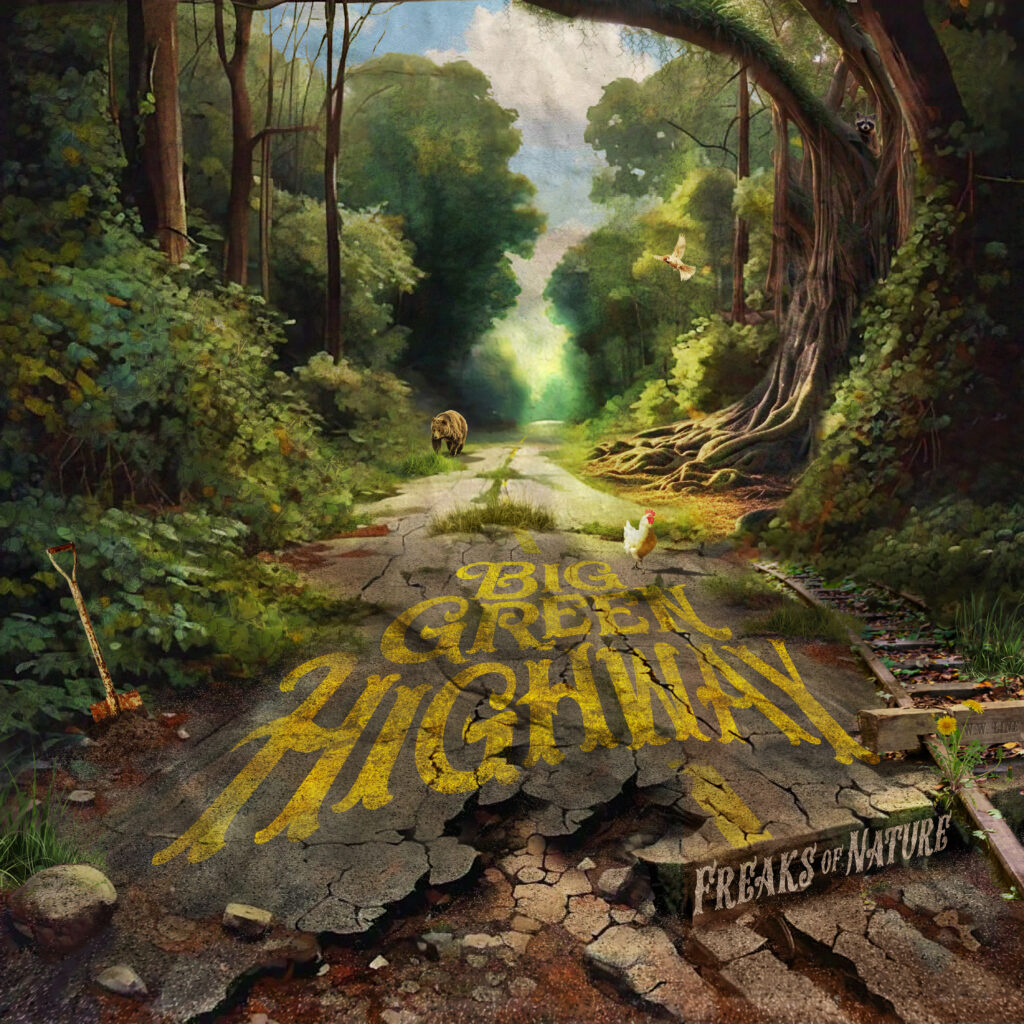
Freaks of Nature songs can be found at Spotify – https://open.spotify.com/artist/6l0RoplxoRnPGixXAvATSK?si=CLckUFpeSZyCuS34KMId-Q and streaming platforms like Apple Music, Pandora, Spotify. To find and listen to their two albums, look up “Left Outside” and “Big Green Highway” by Freaks of Nature.
Jeff Shelley has written and published 10 books as well as numerous articles for print and online media since 1987. Among his titles are three editions of the book, “Golf Courses of the Pacific Northwest.” The Whidbey Island resident was editorial director of Cybergolf.com from 2000-15, co-founder of the Northwest Golf Media Association and president of the nonprofit First Green (https://www.thefirstgreen.org/). To contact Jeff: fairgreens@seanet.com.

